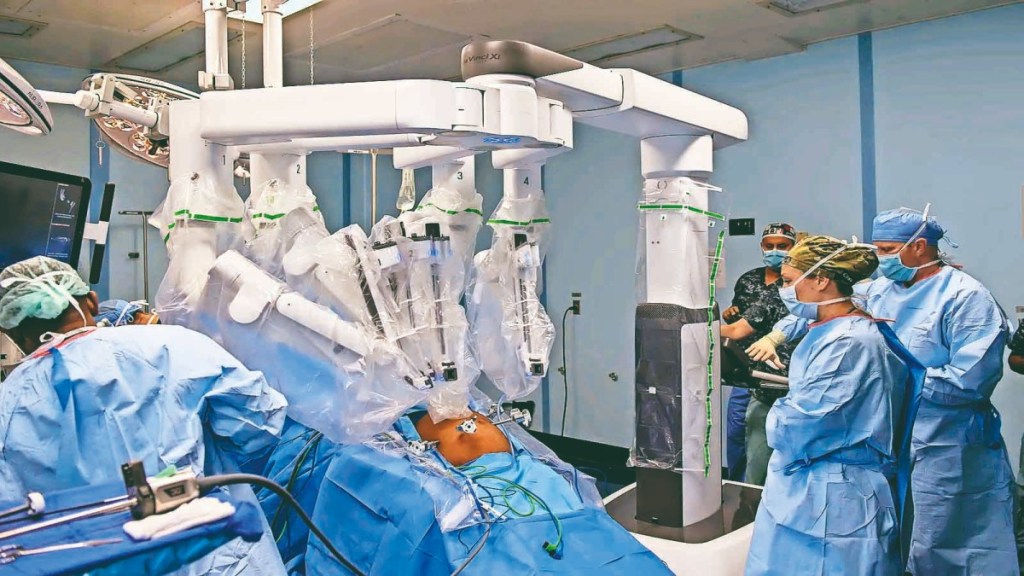The life of a 38-year-old Yemeni patient with chronic mitral valve disease (MVD) — a common cause of congestive heart failure — was saved in just 29 minutes by a robotic procedure at Apollo Hospitals, Bannerghatta Road, Bangalore. The patient came to the hospital in a serious condition and underwent robotic mitral valve replacement with a mechanical valve. Post operative recovery unfolded seamlessly, devoid of any complications, and he was discharged within three days.
In an era where cardiac surgery often involves lengthy procedures and recovery times, the use of robotic systems serves as a beacon of hope for patients. Apollo Hospitals has performed over 150 such robotic mitral valve replacements to date. “Since our first robotic surgery in 2011, we have been at the forefront of adopting and integrating robotic systems into our treatment protocols, significantly enhancing patient care across various specialties,” says Madhu Sasidhar, president and CEO, Apollo Hospitals Group. “Today, Apollo’s robotic surgery programme stands as the largest in India, delivering high-precision, minimally invasive procedures that enable quicker recovery times, reduced pain, and shorter hospital stays,” he highlights.
Apollo Hospitals makes extensive use of robotic systems, particularly the Da Vinci surgical system, across various disciplines such as cardiac surgery, neurosurgery, gynaecology, and more. “Our capabilities are further enhanced by systems like HUGO, ROSA, Mako, and CyberKnife, each strategically selected to ensure our patients receive the highest standard of care tailored to their specific medical needs. For our doctors, robotic systems are revolutionary tools that have become integral to their treatment regimens. The robotic technique allows for greater accuracy and control during the procedure, significantly improving surgical precision and outcomes,” says Sasidhar.
While the technology is still in its early stages compared to global standards, the adoption of robotic systems is growing steadily in India, especially in urban centres and major hospitals in metropolitan areas. It has been steadily increasing in tertiary care centres and specialised hospitals, says Anand Kumar Pandey, senior director — cardiology, Max Super Speciality Hospital, Vaishali, Ghaziabad. Several private hospitals have embraced robotic surgery across various specialities. Fields like cardiology, urology, gynaecology, gastroenterology, and orthopedic surgery are seeing an increase in robotic-assisted procedures, he adds.
Robotic surgery, also known as robot-assisted surgery, has transformed the landscape of surgical procedures in recent times, remarks Sandeep Singh, senior director and head of cardiac surgery at Max Hospital, Vaishali. The watershed moment occurred with the introduction of the da Vinci surgical system in the early 2000s. “It is a minimally invasive surgical technique where specialised robotic systems are employed to assist surgeons in performing procedures with precision and control. They provide a magnified 3D view of the surgical site. For instance, in urological surgery that involves the removal of the prostate gland, robotic systems give surgeons enhanced precision and dexterity. Similarly, in oncology, robotic surgery requires smaller incisions, resulting in less trauma to surrounding tissues, reduced blood loss, and faster recovery times for patients,” he adds.
“For a spine surgeon, robotics is a boon,” says HS Chhabra, chief of spine and rehabilitation centre at Sri Balaji Action Medical Institute, New Delhi. He has to his credit over 300+ robotic-assisted spine surgeries. “The application of robotics is in two fields — surgery and rehabilitation. For surgery, the key benefit is precision in the fixation of the spine; we carry out robotic, computer-navigated and O arm assisted spine surgery. We make use of the Mazor X robotic guidance system so that human error is reduced to a minimum. We have gone in for robotic-assisted rehabilitation equipment that should come to us within the next three to four weeks. Robot assisted treadmill training can assist during gait training of patients suffering from neurologic injuries such as stroke and spinal cord injuries,” he informs.
However, the doctors feel that challenges such as cost, accessibility, and the need for trained personnel continue to limit their widespread adoption. For widespread adoption, efforts need to be made to make these technologies more accessible and affordable. “In cardiac surgery, a robotic-assisted procedure can range anywhere from `3 lakh to `8 lakh, depending on the complexity of the case and the hospital. While the upfront costs are higher, the benefits in terms of patient outcomes, reduced hospital stays, and quicker recovery can offset these expenses in the long run. Also, government hospitals should integrate robotic surgery in their offerings,” says Pandey.
According to Chhabra, most insurance companies deny the claim for robotic surgeries. Even CGHS and ECHS healthcare schemes do not recognise them, despite their proven advantages. While cost is a significant limiting factor for the widespread adoption of robotic systems, the growth prospects remain strong due to increasing demand for advanced healthcare, technological advancements, and potential innovations in costing models like pay by use model etc, feels Atul Kurani, VP, Global Health Medical Practice & IoT, Capgemini Engineering, India.








